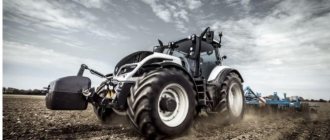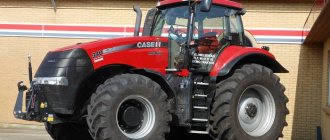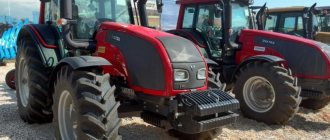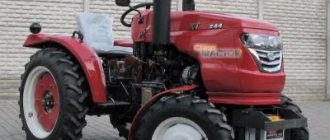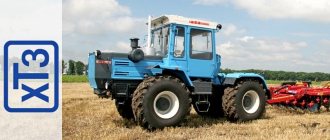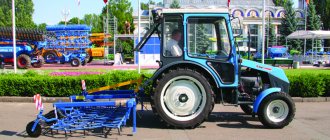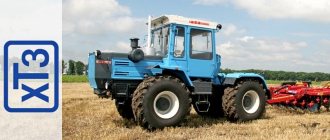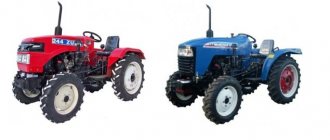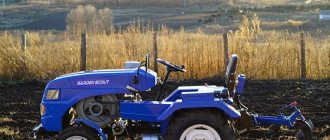Agricultural machinery from the Valtra brand has been known for more than half a century.
Its homeland is considered to be Finland, where since 1951 the production of tractors has been established, the popularity of which today is not limited to the Scandinavian region, but covers the whole world. Valtra tractors have proven themselves to be versatile, wear-resistant and reliable machines. Finnish Valtra tractors are easy to operate even for novice tractor drivers, and the maintenance process is extremely clear and simplified.
Currently, the production of tractors from this manufacturer is 25 thousand units per year. Its production facilities are located not only in Finland itself, but also in Brazil, where propulsion systems are assembled.
Let's take a closer look at the advantages of this manufacturer using the example of specific models from the innovative T-series that have gained popularity in our market.
Valtra T-series tractors: common features of all models
The fourth generation of tractor units has a number of advantages that significantly distinguish them from other tractors:
- AGCO Power motor systems, the capacity of which can reach up to 7.4 liters. Improved electronics and “SCR Stage 4” functionality made it possible to achieve not only reduced fuel consumption, but also reduce the number of emissions harmful to the atmosphere;
- AGCO Power technology - engine turbines are equipped with a special valve, which makes operating the Valtra tractor even easier;
- extensive functionality implemented individually for each model;
- availability of an ergonomic operator's cabin
- “Valtra Arm” - controls are separated as comfortably as possible on the taskbar;
- high power potential, which is in the range of 155-250 hp;
- significant turning radius of the tractor – up to 5.25 m;
- large load capacity - can reach 9 tons or more;
- equipped with adjustable power take-off shafts, which can also operate in synchronous mode;
- minimal care and maintenance - the time range between scheduled technical inspections reaches 600 engine hours;
- low noise impact on workers (up to 70 dB);
- balanced design, and consequently reduced wheel pressure on the soil layer.
Valtra T series
Today, when considering the proposals of European tractor manufacturers, we can say that Valtra is somewhat unusual. He makes this impression primarily due to his distinctive appearance. In recent years, Finnish designers, by their own admission, have nevertheless come closer to the ideas of their colleagues - competitors in this field. Thus, their tractors became more rounded, and the part that protruded significantly forward was shortened. All this also applies to the T-series models, which have been rolling off the Finnish assembly line for about 14 years now. The letter T in their name means that the tractor has a six-cylinder engine. Of course, they have been modernized several times over time. The designations of the first models end in zero
(for example, T 120), and the latest representatives of the series (starting from approximately 2014) - with the number 4 (for example, T 174). Modifications are often related to emissions regulations, but it can also be a design issue. Very often, the new series is equipped with advanced technical solutions, offered as standard or as an additional option. While the engine is strictly assigned to a specific model, the choice of transmission and hydraulics, taking into account their cost, remains with the client. That is why there are a great many different Valtra options available on the secondary tractor market. A buyer interested in purchasing a used tractor may, of course, be delighted by such a variety of offers, but there are big doubts that this fact will make the purchasing decision easier. With great pleasure, buyers begin to compare a variety of car options in order to find the most acceptable, one and only, best preserved, and even the most affordable price. And the more technical differences there are that need to be taken into account, the more difficult it is for them to make a decision. In addition, the selection process becomes more complicated when searching for older Valtra models, presented on the secondary market in relatively small quantities.
In this regard, significant regional differences are very striking,
which are explained by one single reason: an insufficiently diversified dealer network, although thanks to the activation of the sales system over the last decade, the situation has improved significantly. Not so long ago they said about this brand: “If you buy a new Valtra tractor, you make a friend for the rest of your life!”, ironizing primarily over the often disappointing resale value of a used tractor. However, the emergence in recent years of large Valtra dealers with almost 100% territorial coverage has significantly improved the situation. Dealers, in turn, sell and “treat” not only new, but also used tractors of this brand. Of course, you can’t come across specialists with decades of experience in servicing Valtra equipment, but how could it be otherwise? And the spare parts warehouse is replenished mainly with components for the equipment that operates in the corresponding region. And this is quite logical, because the dealer does not need to invest in parts for tractors that are not present in his particular region or were not sold at all. Therefore, before purchasing a used Valtra tractor, you must take into account all of the above circumstances.
However, one should not equate this “exotic” tractor with a shortage of spare parts,
quite the opposite. After all, you're dealing with Europe's fifth-largest tractor manufacturer, which is known for offering solid, practical equipment at reasonable prices. In Scandinavia, that is, in the region with the most active sales, the requirements for this kind of machines are the most serious. And among other things, these countries have strict requirements for equipment used in forestry. In your opinion, who can do it?.. The most important character trait of tractors of this brand is its clearly reliable and robust design, which has proven itself in many areas. For example, all wires laid under the machine body have more reliable and durable protection compared to competitors.
"Valtra" T190
A professional tractor that can be used not only in agriculture, but also for public works.
Advantages:
- SISUDIESEL motor system, which is characterized by an electronic engine control system, easy starting, increased torque;
- innovative fuel supply system - fuel injection speed does not depend on engine speed;
- possibility of choosing a mechanical or hydraulic transmission;
- ergonomic cabin for the tractor driver with air conditioning and climate control functions;
- pneumatic brakes;
- the front axle is equipped with suspension;
- automatic all-wheel drive, which starts a second after turning on the engine;
- Valtra TwinTrac system - efficient movement and work in both forward and rear directions.
Additional options for equipping the Valtra T190 model:
- front power take-off shaft;
- air suspension in the cabin;
- mountain brakes;
- cabin for working in the forest.
Technical characteristics of "Valtra" T190:
- Motor – 66 CTA (CR);
- Power – 189 hp;
- Cylinders – 6 pcs;
- Gas tank – 165 l;
- Additional fuel tank – 170 l;
- Load capacity – 7.7 tons.
- Weight – 5.95 tons.
Valtra T193H tractor – capabilities and equipment
This innovative model stands out among its market counterparts with its modern, productive and economical engine. To develop it, the manufacturer used proprietary AGCO Power technology, which has proven to be an excellent solution for increasing the efficiency of the internal combustion engine and its resistance to loads.
The Valtra tractor is controlled directly from the cab. To achieve this, it is equipped with the Valtra Arm system, thanks to which all switches and levers are located in a place convenient for the driver. The system includes the TwinTrak function - rear controls of the agricultural machine. Additionally, all Finnish Valtra tractors in the T modification are equipped with the AgCommand system, as well as automatically operating steering.
"Valtra" T161C
In terms of technical characteristics and design features, it largely corresponds to the model discussed above. It is a classic all-wheel drive tractor with wide functionality and excellent equipment.
Advantages:
- synchronized manual transmission with 36 gears;
- high operating speed on the highway – up to 40 km/h;
- the presence of a three-position hitch;
- economical fuel consumption - the tractor itself regulates engine speed depending on the load, and primarily operates in the most optimal mode;
- automatic steering column control;
- comfortable workplace for the tractor driver.
Specifications:
- Engine – 66 CTA-4V;
- Thrust – 130 kW;
- The working volume of the motor system is 6.6 l;
- Cylinders – 6;
- Gas tank – 165 l;
- Hydraulic potential – up to 73 l/min;
- Additional fuel tank – 170 l;
- Load capacity – 7.7 tons.
- Weight – 5.95 tons.
Agricultural tractor (Valtra T)
Designed to perform various agricultural work performed in a unit with semi-mounted, mounted and trailed machines and implements.
All models of T-series tractors are equipped with SisuDiesel engines with a Common Rail fuel system, the design of which includes a number of improvements that improve the combustion process and reduce the toxicity of exhaust gases.
Engines with a common rail fuel system are equipped with a third generation electronic engine management (EEM). The EEM system has a number of progressive functions, such as reducing engine speed (650 rpm) when the parking brake is applied or increasing the power of Transport boost (this function is available in HiTech and Advance models).
Common Rail fuel system. The system injects fuel in stages, up to five times per operating cycle. The electronic engine control unit calculates the amount of fuel required for injection and the amount of cyclic feed correction more than 100 times per second. Thanks to multi-stage fuel injection, exhaust gas toxicity is significantly reduced. At the same time, the fuel efficiency of the engine is maintained.
- Advantages of engines with a Common Rail (CR) fuel system:
- Exceeding the requirements of the Tier III exhaust gas toxicity standard;
- High fuel injection pressure, precise injection timing and effective intercooling of the charge air reduce the emissions of harmful substances from the exhaust gases;
- High torque at low engine speeds. Torque does not decrease as rpm drops under load, resulting in improved performance and fuel economy;
- Design features that increase the durability of SisuDiesel engines:
- Charge air intercooler;
- Wet cylinder liners have an additional installation belt in the middle part;
- Vibration of cylinder liners is reduced, wear of cylinder liners and pistons is reduced to a minimum;
- Low oil consumption;
- The fuel supply system is located on the side of the engine where there is no manifold heated to a high temperature;
- The fuel filter can be replaced without tools and without fuel leakage;
- Free access to service points;
Engine speed reduction function. The crankshaft rotation speed at minimum engine speed is 850 rpm. After applying the parking brake during a stop, the minimum engine speed is reduced to 650 rpm, fuel consumption is reduced. Before the tractor starts moving, the shuttle mechanism lever is moved to position N, the crankshaft speed increases from 650 rpm to 850 rpm to provide sufficient torque to start moving.
Power bulge technology allows the engine to produce maximum power at lower engine speeds. The rated speed of CR engines for T Series tractors is 2200 rpm, with maximum power achieved at 2000 rpm. The increase in power thanks to Power bulge technology is about 3-4 liters. With.
Permatorque function provides a large torque reserve in the range from rated speed to the speed at which maximum torque is achieved. T series tractor engines develop maximum torque at a crankshaft speed of 1500 rpm (EcoPower engine - at 1100 rpm). The Permatorque constant torque range starts at 1000 rpm. High torque at low speeds ensures smooth engagement of the PTO, as well as smooth starting when transporting heavy loads.
Transport boost power boost feature for common rail engines is designed to improve efficiency when towing and transporting implements. The increase in power is 5-6 percent when driving at operating speeds. The Transport boost function provides increased power in gears H2, H3 and H4. In Transport boost mode, the Power bulge function can also be enabled.
SisuDiesel engines with a common rail fuel system comply with the Tier 3 standard for the content of harmful substances in exhaust gases and can operate on a mixture containing up to 20% Biodiesel biofuel (B20).
The advantage of the new generation EcoPower engines is the ability to select one of two operating modes: economical Eco and standard Power (model T 151e).
- Eco Mode:
- rated speed 1800 rpm;
- reduction in fuel consumption up to 10%;
- low noise level;
- low piston speed, increased engine life;
- high torque, already at 1000 rpm;
- constant torque over a wide speed range;
- Power Mode:
- rated speed 2200 rpm;
- additional power increase thanks to the Transport boost function is 11 hp. With. (8 kW);
- maximum speed 50 km/h;
- high torque on the PTO;
Eco mode is recommended for reducing fuel consumption, for performing soil cultivation operations, and for performing work in public utilities. Maximum power of 117 kW (159 hp) is achieved at 1800 rpm. The Transport boost function provides increased power in the H2, H3 and H4 gears, and at 1800 rpm the power is 127 kW (173 hp).
Power mode is recommended for performing work that requires high torque on the PTO, to achieve high average speed, for example, on hilly terrain, to ensure high performance of the hydraulic system pump. Maximum power of 120 kW (163 hp) is achieved at 2000 rpm. The Transport boost function provides increased power in H2, H3 and H4 gears, and at 2000 rpm the power is 127 kW (173 hp).
- EcoSpeed functionSuitable for countries with tractor speed limits up to 40 km/h. The EcoSpeed function is equipped with tractors with a transmission designed for a speed of 50 km/h; the function limits the tractor speed to 40 km/h (no more than 43).
- The rotation speed of the engine crankshaft when the tractor is moving at a speed of 40 km/h is about 1800 rpm, depending on the size of the wheels.
- Travel speed in H4 gear, with Delta PS transmission in 2nd gear - 40 km/h at 2200 rpm.
- Travel speed in H4 gear, with Delta PS transmission in 3rd gear - 40 km/h at 1800 rpm.
- Reduced fuel consumption.
- Reduced noise level and wear of parts.
- Installed on tractors models T131-T191. (the remaining speeds of tractors with the EcoSpeed function do not differ from the speeds of tractors with a transmission designed for a maximum speed of 50 km/h).
Sigma Power function to increase power at the PTO. The rated engine power on T191 Sigma Power tractors is 189 hp. As the PTO load increases, the engine power increases to 211 hp, thus providing an additional 22 hp. transmitted to the PTO. Sigma Power models are suitable for work with attachments that require high PTO power, such as rotary harrows or stalk choppers.
Using cruise control, the driver can set a constant tractor speed or engine speed. The set speed (rotation frequency) is maintained automatically, regardless of changes in the load on the engine. When making a turn at the end of a lane or stopping operation, the engine speed may be temporarily reduced to the minimum speed or to another previously set value.
The Valtra Power Control electronic control system, depending on the operation being performed and the load, itself selects the optimal operating mode for the direction of travel mechanism, all-wheel drive, clutch (controlled using the HiShift button), Powershift transmission and PTO.
You can switch the direction of movement using the joystick without disengaging the clutch. In this case, the change in direction occurs smoothly and quickly, regardless of the weight of the cargo being transported. In addition, you can use the joystick to turn the parking brake on/off. Once the electronic clutch control function is activated using the HiShift button, the driver does not need to use the clutch pedal to change gears or ranges. The clutch pedal will only have to be used to perform particularly precise movements of the tractor.
Transmission with programmable shift modes Auto 1 and Auto 2 Powershift. Gear shifting of the Powershift transmission is carried out either using buttons or in one of two automatic modes specified by the corresponding programs. In Auto 1 or Auto 2 modes, gear shifts automatically when the engine speed reaches a preset upper or lower limit.
- Auto 1 automatic gear shift mode. In Auto 1 automatic gear shift mode, the electronic control system Power Control independently selects the optimal gear as soon as the engine speed exceeds or falls below the speed values set in the program. Automatic gear shift mode Auto 1 is set at the factory. Auto 1 mode is suitable for field work and work carried out using PTO-driven equipment, as well as for transporting loads.
- Auto 2 automatic gear shift mode. Auto 2 automatic gear shift mode allows the driver to independently set the engine speed to switch to a specific gear, depending on the type of work being performed. The Power Control electronic control system then automatically changes gears. Auto 2 automatic shift mode allows for greater efficiency when using different tractor and implement combinations.
Kick-down function. Automatic gearshift modes Auto 1 and Auto 2 allow you to use the kick-down function, which is designed to change gears during acceleration. If the driver presses the accelerator pedal sharply, the system will temporarily downshift, if possible. This function is also used when braking.
The AutoTraction system automatically disables transmission of torque to the wheels if the driver presses the brake pedal when the tractor speed is less than 10 km/h or if the engine speed drops below 1000 rpm. After the crankshaft speed rises above 1000 rpm or if the driver releases the brake pedal, the wheel drive smoothly engages. AutoTraction is suitable for jobs that involve frequent stops and starts.
The automatic all-wheel drive (4WD) system prevents wheel slipping and damage to the top layer of soil.
The system automatically engages (briefly) four-wheel drive when driving away, changing gears, pressing the HiShift button or changing direction. The duration of all-wheel drive activation can be set by the driver. If necessary, the automatic all-wheel drive system can be disabled. The driver can choose automatic or manual mode for engaging all-wheel drive and differential locking. Transmission and hydraulic control systems
| Classic | HiTech | Advance | ||||||||||||
| T | 121 | 131 | 161 | 171 | 121 | 131 | 151e | 161 | 171 | 191 | 151e | 161 | 171 | 191 |
| Control | mechanical | electronic transmission / mechanical hydraulic system | electronic | |||||||||||
| Clutch type | dry | double, multi-disc wet type (forward/backward) | ||||||||||||
| Shuttle mechanism | mechanical, synchronized | electrohydraulic, without pedal | ||||||||||||
| Shifting gears with the clutch not disengaged | manual, with electrohydraulic drive | electrohydraulic with computer control, programmable by the driver | ||||||||||||
| Four-wheel drive | manual or automatic control (together with brakes and differential lock) | |||||||||||||
| Differential lock | manual or automatic control (together with brakes and linkage mechanism) | |||||||||||||
| Parking brake | mechanical | HiBrake, hydraulic control via shuttle lever | ||||||||||||
| Hydraulic system | Autocontrol B in conjunction with Drive Balance Control | Autocontrol DS with traction control | ||||||||||||
"Valtra" T191N
A wheeled tractor equipped with a water-cooled diesel engine marked Sisu 74 STA 4V, the capacity of which is 7.4 liters. The control of this system is controlled electronically.
Peculiarities:
- six-cylinder engine;
- 36-speed transmission, in which 10 gears operate at speeds of 4-12 km/h;
- hydraulic multi-disc brakes;
- additional gas tank for storing diesel.
Technical characteristics of "Valtra" T191H:
- Effort – 185 hp;
- The total volume of gas tanks is 335 l;
- Weight – 11 tons.
Valtra tractors: features and overview of the model range
Agricultural machinery from the Valtra brand has been known for more than half a century.
Its homeland is considered to be Finland, where since 1951 the production of tractors has been established, the popularity of which today is not limited to the Scandinavian region, but covers the whole world. Valtra tractors have proven themselves to be versatile, wear-resistant and reliable machines. Finnish Valtra tractors are easy to operate even for novice tractor drivers, and the maintenance process is extremely clear and simplified.
Currently, the production of tractors from this manufacturer is 25 thousand units per year. Its production facilities are located not only in Finland itself, but also in Brazil, where propulsion systems are assembled.
Let's take a closer look at the advantages of this manufacturer using the example of specific models from the innovative T-series that have gained popularity in our market.
Model range of Valtra tractors
Valtra tractors are suitable for a wide range of work in rural and urban municipal services. Optimally selected attachments and their technical capabilities allow these units to operate all year round. The model range of Valtra tractors is represented by 4 series, which differ slightly in design and technical characteristics, as well as in the design of the cabin.
Serie A
The main purpose of Valtra tractors of this series is to work in confined spaces (livestock farms, garden farms, vineyards, etc.). Very light, maneuverable and balanced. In addition to application in agriculture, they are also actively used in other industries.
Models in the line are equipped with 3-cylinder engines with power ranging from 85 to 100 hp. High ground clearance and a long wheelbase make these tractors passable and balanced. In addition to a powerful two-speed power take-off shaft, there is a front loader.
Series N
Valtra tractors in this series are represented by more productive and powerful models than previous ones. Also equipped with a front loader, a reliable, economical engine with low noise and emissions. The power range of installed engines is from 99 to 171 hp. With. They are successfully used in agriculture, public utilities, forestry, and construction.
Series T
These Valtra tractors combine comfortable working conditions for the operator with high productivity. Suitable for difficult operating conditions. For the optimal combination of price, performance and quality, the series is considered the most popular among consumers. The engine is characterized by economical fuel consumption and has an installed exhaust gas purification system. Power range – from 170 to 225 hp. With.
Valtra tractors
Valtra is known throughout the world for its reliable technology with innovative features. It designs, builds and maintains the finest Valtra tractors.
Finnish Valtra tractors first entered the market in 1951, but the company itself has a longer history. Thanks to a special approach to the creation of such equipment, it is distinguished by its versatility, reliability and durability. Absolutely every Valtra model can work in the most difficult conditions and in harsh climates.
Valtra tractors: features, design, characteristics
Finnish Valtra tractors have been produced by the Scandinavian company of the same name for more than 50 years. Founded as a result of the merger of Valmet and Volvo. The company focuses on its customer focus, expanding its dealer network - Valtra has representative offices in more than 75 countries around the world.
The products are famous for their versatility, reliability and long service life, capable of working in extreme and difficult conditions. In terms of performance and multi-functionality, these units are similar to the Belarus 1523 tractors. Each new batch takes into account the individual wishes of customers and technical innovations in the field of mechanical engineering. The company's annual production volumes are around 25,000 units of equipment.
Tractor Valtra T191H
This model belongs to the T series and is professional-class equipment. The Valtra T 191N tractor is distinguished by increased power and versatility. It can be used for almost any type of work.
Main characteristics:
- motor 74 CTA-4V;
- power is 138 kW;
- the fuel tank has a volume of 165 l;
- use of a three-point hitch;
- transmission: 36 forward and reverse gears;
- speed – up to 40 km/h.
